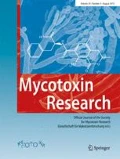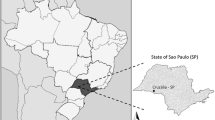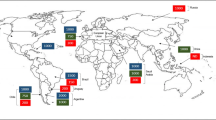Abstract
The European corn borer reportedly promotes the infection of maize by Fusarium spp. Stalk and ear rots caused by Fusarium spp. are often related to mycotoxin accumulation in maize kernels. As a result, food and animal feed from maize are more severely contaminated with Fusarium mycotoxins: e.g. fumonisins (FUM), deoxynivalenol (DON) and zearalenone (ZEA). Bt maize is primarily an important potential tool for insect pest protection, both in the European Union and in other countries. Bt maize carrying the Bt genes is highly resistant to European corn borer larval feeding due to Bt toxin (δ toxin) production. Effective measures to combat pests therefore often have a positive side-effect in that they also reduce mycotoxin levels. Comparative analysis was used to the evaluation of the studies dealing with the reduction of Fusarium mycotoxins in Bt maize. Nineteen out of 23 studies on Bt maize came to the conclusion that Bt maize is less contaminated with mycotoxins (FUM, DON, ZEA) than the conventional control variety in each case.
Similar content being viewed by others
References
Aulrich K, Bohme H, Daenicke R, Halle I, Flachowsky G (2001) Genetically modified feeds (GMO) in animal nutrition: Bacillus thuringiensis (Bt) corn in poultry, pig and ruminant nutrition. Arch Anim Nutr 54:183–195
Bakan B, Melcion D, Richard-Molard D, Cahagnier B (2002) Fungal growth and Fusarium mycotoxin content in isogenic traditional maize and genetically modified maize grown in France and Spain. J Agric Food Chem 50(4):728–731
Barros G, Magnoli C, Reynoso MM, Ramirez ML, Farnochi MC, Torres A, Dalcero M, Sequeira J, Rubinstein C, Chulze S (2009) Fungal and mycotoxin contamination in Bt maize and non-Bt maize grown in Argentina. World Mycotoxin J 2:53–60
Chung OK, Park SH, Kim Y (2007) Concerted efforts in cereal grain quality improvement. ICC International Conference on cereals and cereal products quality and safety, Rosario, Argentina, 23-26 September 2007.
Clements MJ, Campbell KW, Maragos CM, Pilcher C, Headrick JM, Pataky JK, White DC (2003) Influence of Cry1Ab protein and hybrid genotype on fumonisin contamination and Fusarium ear rot of corn. Crop Sci 43:1283–1293
De la Campa R, Hooker DC, Miller JD, Schaafsma AW, Hammond BG (2005) Modeling effects of environment, insect damage, and Bt genotypes on fumonisin accumulation in maize in Argentina and the Philippines. Mycopathologia 159:539–552
Dowd PF (1998) Involvement of arthropods in the establishment of mycotoxigenic fungi under field conditions. In: Sinha KK, Bhatnagar D (eds) Mycotoxins in agriculture and food safety. Marcel Dekker, New York, pp 307–350
Dowd PF (2001) Biotic and abiotic factors limiting efficacy of Bt corn in indirectly reducing mycotoxin levels in commercial fields. J Econ Entomol 94:1067–1074
GMO Compass (2009) GM maize in the EU (http://www.gmo-compass.org/eng/grocery_shopping/crops/18.genetically_modified_maize_eu.html)
Hammond BK, Campbell C, Pilcher T, De Gooyer A, Robinson L, Rice A, Pietri G Piva, Melcion D, Cahagnier B (2002) Reduction of fungal and fumonisin levels in Bt corn. Mycopathologia 155:22
Hammond BG, Campbell KW, Pilcher CD, De Gooyer TA, Robinson AE, McMillen BL et al (2004) Lower fumonisin mycotoxin levels in the graint of Bt corn grown in the United States in 2000–2002. J Agric Food Chem 52:1390–1397
Magg T, Melchinger AE, Klein D, Bohn M (2002) Relationship between European corn borer resistance and concentration of mycotoxins produced by Fusarium spp. in grains of transgenic Bt maize hybrids, their isogenic counterparts, and commercial varieties. Plant Breed 121:146–154
Masoero F, Moschini M, Rossi F, Prandini A, Pietri A (1999) Nutritive value, mycotoxin contamination and in vitro rumen fermentation of normal and genetically modified corn (Cry 1A(B)) grown in northern Italy. Maydica 44:205–209
Munkvold GP, Desjardins AE (1997) Fumonisins in maize—can we reduce their occurrence. Plant Dis 81:556–565
Munkvold GP, Hellmich RL, Rice LG (1999) Comparison of fumonisin concentrations in kernels of transgenic Bt maize hybrids and nontransgenic hybrids. Plant Dis 83:130–138
Munkvold GP, Hellmich RL, Showers WB (1997) Reduced Fusarium ear rot and symptomless infection in kernels of maize genetically engineered for European corn borer resistance. Phytopathology 87:1071–1077
Naef A, Zesiger T, Défago G (2006) Impact of transgenic Bt maize residues on the mycotoxigenic plant pathogen Fusarium graminearum and the biocontrol agent Trichoderma atroviride. J Environ Qual 35:1001–1009
Papst C, Utz HF, Melchinger AE, Eder J, Magg T, Klein D, Bohn M (2005) Mycotoxins produced by Fusarium spp. in isogenic Bt vs. non-Bt maize hybrids under European corn borer pressure. Agron J 97:219–224
Schaafsma AW, Hooker DC, Baute TS, Illincic-Tamburic L (2002) Effect of Bt-corn hybrids on deoxynivalenol content in grain at harvest. Plant Dis 86(10):1123–1126
Schulthess F, Cardwell KF, Gounou S (2002) The effect of endophytic Fusarium verticillioides on infestation of two maize varieties by lepidopterous stemborers and coleopteran grain feeders. Phytopathology 92:120–128
Strosnider H, Azziz-Baumgartner E, Banziger M, Bhat RV, Breiman R, Brune MN, DeCock K, Dilley A, Groopman J, Hell K et al (2006) Workgroup report: public health strategies for reducing aflatoxin exposure in developing countries. Environ Health Perspect 114:1898–1903
Valenta H, Dänicke S, Flachowsky G, Böhme T (2001) Comparative study on concentrations of deoxynivalenol and zearalenone in kernels of transgenic Bt maize hybrids and nontransgenic maize hybrids. Mycotoxin Res 17:15–18
Wu F (2004) Explaining consumer resistance to genetically modified corn: an analysis of the distribution of benefits and risks. Risk Anal 24:717–728
Wu F (2006a) Mycotoxin reduction in Bt corn: potential economic, health and regulatory impacts. Transgenic Res 15:277–189
Wu F (2006b) An analysis of Bt corn’s benefits and risks for national and regional policymakers considering Bt corn adoption. Inter J Technol Global 2:115–136
Wu F (2007) Bt corn and mycotoxin reduction. CAB Reviews: Perspectives in Agriculture, Veterinary Science, Nutrition and Natural Resources 2(060), CABI, Oxford
Wu F, Miller JD, Casman EA (2004) Bt corn and mycotoxin reduction: economic impacts in the United States and the developing world. J Toxicol Toxin Rev 23:397–424
Acknowledgements
Financial support for this work was provided by the Czech Scientific Committee on Genetically modified Food and Feed.
Author information
Authors and Affiliations
Corresponding author
Rights and permissions
About this article
Cite this article
Ostry, V., Ovesna, J., Skarkova, J. et al. A review on comparative data concerning Fusarium mycotoxins in Bt maize and non-Bt isogenic maize. Mycotox Res 26, 141–145 (2010). https://doi.org/10.1007/s12550-010-0056-5
Received:
Revised:
Accepted:
Published:
Issue Date:
DOI: https://doi.org/10.1007/s12550-010-0056-5




